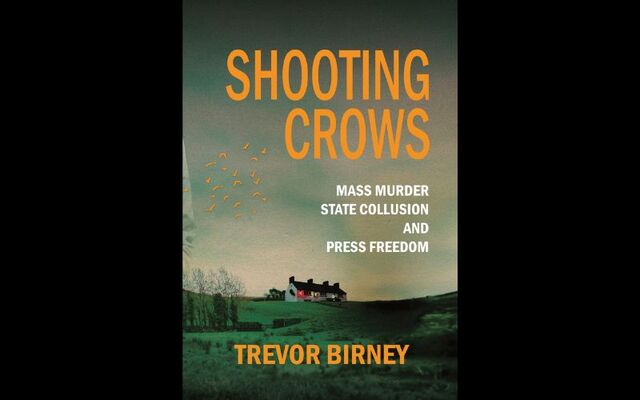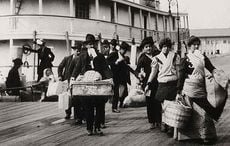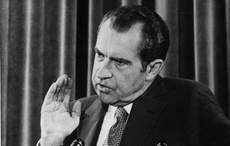"Shooting Crows: Mass Murder, State Collusion and Press Freedom" is a new book by renowned Northern Ireland journalist Trevor Birney into the extent and scope of collusion by British army and police in the cover-up of one of the most infamous episodes of The Troubles - the Loughinisland murders.
For the book which is being launched in the US this month, Birney worked with award-winning filmmaker Alex Gibney who produced the documentary "No Stone Unturned," upon which the book is partly based.
Birney's new book reads like fiction because the facts it reveals are so incredible. Police and army and paramilitary forces worked hand in glove to commit six murders of innocent Irish soccer fans then launched a cover-up to desperately try and hide the tracks.
But if not for Birney and fellow journalist Barry McCaffrey, the two journalists who dug deep into the story, the corrupt authorities might just have gotten away with it.
The killings occurred against the backdrop of arguably the biggest Irish sports story ever, which was Ireland's World Cup victory over tournament favorites Italy in June 1994 in the sweltering heat of a New Jersey high noon. In the biggest tournament in sport, against one of the great traditional powers in world soccer, the Irish somehow gleaned a victory over the stunned Azzurri who had eyes on the Jules Rimet trophy and clearly underestimated the L'Irlanda team.
I was one of those 80,000 present and will never forget the glorious aftermath - until the unbelievable story from Ireland winged its way across the wires. The greatest story in Irish sport would not grace the front pages in Ireland or anywhere. Instead, it would be secondary to one of the most dreadful killings of The Troubles.
The news was there had been a massacre of horrific proportions in a little Irish pub called The Heights in the townland of Loughinisland, a beautiful village nestling in the Mourne Mountains a few short miles from the Irish border. A group of locals numbering 24 had gathered to watch the game and were in fine fettle as the Irish clung on to their one-goal lead.
Suddenly, the bar door slammed open and two armed men entered. One screamed "Fenian bastards" and began shooting. His fellow killer also blazed away, shattering glasses, and punching bullet holes everywhere as the bar patrons slumped to the ground, dead or injured.
It was utter chaos.
When the smoke cleared, six patrons lay dead, including an 87-year-old man. Five were injured.
The getaway car was discovered poorly camouflaged a short distance away. Witnesses came forward testifying that they saw a gang of three armed men stop outside the pub and two raced inside, guns loaded. Boiler suits and gloves were found close to the abandoned car. There seemed to be an open and shut case in the offing.
But nothing is as it seems in the Northern Ireland of The Troubles. The RUC, the deeply mistrusted police force among nationalists, arrived. A local Ulster Volunteer Force leader with close ties to the leaders in Belfast was named a main suspect. It looked like a solvable murder.
It took until 2016 and the Ombudsman's report 22 years later to force the British government into admitting there was deep collusion involved in the killings. Indeed, one of the men was a British agent who had phoned his handler in the British Army before the killing to give him all the details.
The source of the weapons used was a consignment of powerful semi-automatic rifles shipped in from South Africa by a top British Army agent Brian Nelson. The RUC and Army were well aware of the shipment.
Dr. Michael Maguire, the Police Ombudsman who investigated the killings, made a dramatic statement that, in his opinion: "I have no hesitation in unambiguously determining that collusion is a significant feature of the Loughinisland murders."
Still, decades after the massacre, no one has ever been charged. However, in an extraordinary shift, Birney and McCaffrey, who named the chief suspect in their documentary, were arrested in 2018 on the grounds that they endangered the chief suspect's safety. The alleged killer settled right back into farming life as the RUC refused to dig deep for the truth behind the killings.
The two journalists who were jailed and put in mortal danger by senior figures in the RUC risked extensive jail time because of their stellar work unspooling the case.
The main piece of evidence, a secret file on the killings held by the RUC, was sent to them by the wife of the chief suspect, another incredible twist. How they got that file led to their arrest and accusations of compromising the safety of the gang leader.
Journalists arrested for investigating the mass murder of six innocent people was setting truth on its head.
They ultimately won their court battle to prove their innocence, which would have left them with huge legal bills if they had failed.
The entire book is a gripping narrative of what happens when cops aid killers as happened in Loughinisland. It is scant consolation for those families torn apart by the killings. If you wish to visit the darkness of the era and how two intrepid journalists fought for justice and keeping themselves out of prison this is an outstanding book to read and reflect on.
You can learn more about Trevor Birney's "Shooting Crows: Mass Murder, State Collusion and Press Freedom" here.




Comments